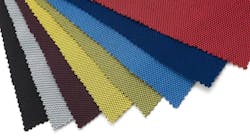Textile designer Elizabeth Whelan wants interior designers to know that fabric should not be overlooked when it comes to products, especially ergonomic chairs.
“There’s no reason why we can’t have really high standards for the fabrics on ergonomic chairs – they don’t need to be just toppings,” she says. “I know there are price point considerations, but you can still design well. I think we can have beautiful colors and interesting patterns, and it can feel good. So when someone is sitting in a chair all day, they enjoy the experience.”
It’s a sentiment Whelan infused into designing Fourtis, a versatile performance textile she created for ergonomic product manufacturer Humanscale.
Introducing Fourtis
For Whelan, Fourtis is nearly 20 years in the making. She began working with Humanscale in 1999 when the company launched its Freedom Chair, which was covered in a black knit swimsuit fabric for four-way stretch capabilities (meaning it stretches top to bottom and side to side).
“There was not enough heavy-duty wear for these ergonomic chairs,” Whelan says, “which are more like sitting machines than they are like chairs.”
Those fabrics failed, and Whelan was tasked with designing a four-way stretch fabric that had performance, functional and aesthetic aspects. The fabric needed to conform to the unique shape of the body while not contorting the cushion.
More Ergonomic Chairs: Summa from Humanscale
It soon became one of her toughest challenges – the mills she needed to work with were not easy to find. Then only a few years later, the project was halted to focus on Humanscale’s Liberty Chair with mesh fabric.
Get more interior design on Instagram
But Whelan always had that elusive stretch fabric in the back of her mind. Several years of designing mesh fabrics, she finally had the opportunity to return to stretch, where she focused on weaving. “It needed to be woven because woven would hold up and would address those aspects we needed, and it would be a much heartier fabric,” she says.
She eventually found a few stretch mills and brought her ideas to them. Now, Fourtis has launched in a palette of earthy hues. Its unique weave, offering four-way stretch, closely conforms to Humanscale’s ergonomic seat cushions and allows end-users to feel fully supported. It also features a black warp yarn for impactful detail. Fourtis is meant to be the second standard stretch fabric for Humanscale.
“We really approached this from, ‘What does this fabric need to do?’” explains Whelan. “The fabric needed to be on task chair across the line. It needed to be another proprietary stretch fabric at Humanscale. And it needed to look good and last.”
The Future of Fabric
Ergonomic chairs are lauded for their incredible features – from tilt mechanisms, increased comfort to promoting better posture and circulation. But that doesn’t mean interior designers should turn a blind eye to their upholstery.
“I think fabric plays a really important role that has been overlooked,” Whelan says.
She adds that Humanscale has been supportive of her process to design from the ground up, which has hit home the idea that “the fabrics we put on our products matter.” She advises interior designers to make their requests and standards known, whether they’re dealing with a mill design director or a chair manufacturer.
With Fourtis, Whelan hopes the line will help her and Humanscale “move the market on what the future of fabric textile design will be.”
More on Ergonomics: Design for Wellness – Evoking Beauty, Nature and Welcome
Something Else: The Race for Healthy and Sustainable Materials Heats Up
